Reflection on Guangzhou’s Strategic Spatial Planning: Current Status, Conflicts, and Dilemmas
Abstract
:1. Introduction
2. Literature Review
2.1. The Concept of Strategic Spatial Planning
2.2. Planning Implementation Evaluation
2.3. Academic Debate: “Leapfrog” vs. “Spillover”
2.3.1. The Leapfrog Pattern
2.3.2. The Spillover Pattern
2.3.3. Spatial Development Patterns in the “Guangzhou Strategic Spatial Plan”
3. Materials and Methods
3.1. Study Area
3.2. Methods
3.2.1. Distribution of Infrastructure
3.2.2. Distribution of Residential and Workplace
3.2.3. Distribution of Enterprises
3.2.4. Planning Documents Analysis
4. Results
4.1. Distribution of Infrastructure
4.2. Distribution of Population
4.3. Industrial Development
5. Discussion of Challenges
5.1. Why Did the Southward Expansion Fail?
5.1.1. Nansha’s Inherent Limitations
5.1.2. Multi-Level Government Orientation Differences
5.1.3. Strategic Spatial Planning without Legal Constraints
5.2. The Southward Expansion Dilemma
6. Conclusions
Author Contributions
Funding
Data Availability Statement
Conflicts of Interest
References
- Albrechts, L. Strategic (Spatial) Planning Reexamined. Environ. Plan. B Plan. Des. 2004, 31, 743–758. [Google Scholar] [CrossRef]
- Albrechts, L. Shifts in Strategic Spatial Planning? Some Evidence from Europe and Australia. Environ. Plan. A Econ. Space 2006, 38, 1149. [Google Scholar]
- Xu, J.Z. The urban planning trends in China in the 1980s. City Plan. Rev. 2018, 42, 5–38+3–4. [Google Scholar]
- Hall, P.; Day, S.; Phe, H.H.; Ryser, J.; Sloan, D. Future urban lifestyles. In BBR Bundesamt für Bauwesen und Raumordnung ed.; Urban Future; Forschungen: Munich, Germany, 1999; Volume 92, pp. 31–40. [Google Scholar]
- Wong, S.W.; Tang, B.S.; Basil, V.H. Strategic urban management in China: A case study of Guangzhou Development District. Habitat Int. 2006, 30, 645–667. [Google Scholar] [CrossRef]
- Wu, F.L. Re-orientation of the city plan: Strategic planning and design competition in China. Geoforum 2007, 38, 379–392. [Google Scholar] [CrossRef]
- Liedtka, J. Strategic Planning as a Contributor to Strategic Change: A Generative Model. Eur. Manag. J. 2000, 18, 195–206. [Google Scholar]
- Jiang, X.; Yeh, A.G.O. Guangzhou. Cities 2003, 20, 361–374. [Google Scholar]
- Lu, C.T.; Wu, C.; Huang, D.X. From concept planning to structural planning: Review and innovation of strategic plan of Guangzhou. City Plan. Rev. 2010, 34, 17–24. (In Chinese) [Google Scholar]
- Zhao, Y.J. On the theoretical foundation and methodology of concept planning. City Plan. Rev. 2001, 3, 38–52. (In Chinese) [Google Scholar]
- Wang, M.H.; Duan, X.F.; Tian, L.; Chen, Y.; Ye, H.; Huang, Z. The practice of concept planning for the city of Guangzhou. City Plan. Rev. 2001, 3, 10. (In Chinese) [Google Scholar]
- Friedmann, J. Strategic spatial planning and the longer range. Plan. Theory Pract. 2004, 5, 49–67. [Google Scholar] [CrossRef]
- Healey, P. Urban Complexity and Spatial Strategies: Towards a Relational Planning for Our Times; Routledge: London, UK; New York, NY, USA, 2007. [Google Scholar]
- Healey, P. Relational complexity and the imaginative power of strategic spatial planning. Eur. Plan. Stud. 2006, 14, 525–546. [Google Scholar] [CrossRef]
- Healey, P. Researching Planning Practice. Town Plan. Rev. 1991, 62, 447–459. [Google Scholar] [CrossRef]
- Albrechts, L. Reframing strategic spatial planning by using a coproduction perspective. Plan. Theory 2013, 12, 46–63. [Google Scholar] [CrossRef]
- Albrechts, L.; Healey, P.; Kunzmann, K.R. Strategic spatial planning and regional governance in Europe. J. Am. Plan. Assoc. 2003, 69, 113–129. [Google Scholar] [CrossRef]
- Kaufman, J.L.; Jacobs, H.M. A Public Planning Perspective on Strategic Planning. J. Am. Plan. Assoc. 1987, 53, 23–33. [Google Scholar] [CrossRef]
- Sartorio, F.S. Strategic spatial planning: A historical review of approaches, its recent revival, and an overview of the state of the art in Italy. DisP-Plan. Rev. 2005, 41, 26–40. [Google Scholar] [CrossRef]
- Todes, A. New directions in spatial planning? Linking strategic spatial planning and infrastructure development. J. Plan. Educ. Res. 2012, 32, 400–414. [Google Scholar] [CrossRef]
- Xiao, H.W.; Zhao, M.; Zhang, J.; Wang, Q.X. Multi-scale Spatial Connectivity and Planning Agendas of New Town Development in the New Era: The Cases of Beijing, Shanghai, and Guangzhou. Urban Plan. Forum 2022, 6, 18–27. (In Chinese) [Google Scholar]
- Gennaio, M.; Hersperger, A.M.; Buergi, M. Containing urban sprawl-evaluating effectiveness of urban growth boundaries set by the Swiss Land Use Plan. Land Use Policy 2009, 26, 224–232. [Google Scholar] [CrossRef]
- Herbst, H.; Herbst, V. The development of an evaluation method using a geographic information system to determine the importance of wasteland sites as urban wildlife areas. Landsc. Urban Plan. 2006, 77, 178–195. [Google Scholar] [CrossRef]
- Xi, G.L.; Zhen, F.; Chang, E.Y. Measuring urban space of flows in information era: Empirical evidence from Nanjing, China. Int. Rev. Spat. Plan. Sustain. Dev. 2016, 4, 42–57. [Google Scholar] [CrossRef]
- Deng, Y.; Liu, J.; Liu, Y.; Luo, A. Detecting Urban Polycentric Structure from POI Data. ISPRS Int. J. Geo-Inf. 2019, 8, 283. [Google Scholar] [CrossRef]
- Xiao, Y.; Wang, Y.; Miao, S.; Niu, X. Assessing polycentric urban development in Shanghai, China, with detailed passive mobile phone data. Environ. Plan. B Urban Anal. City Sci. 2021, 48, 2656–2674. [Google Scholar] [CrossRef]
- Li, Y.S.Q.; Li, W.F.; Li, X.; Webster, C. Developer obligations and negotiation-based benefit distribution in urban redevelopment: Evidence from Shenzhen, China. Cities 2023, 134, 104166. [Google Scholar] [CrossRef]
- Laurian, L.; DAY, M.; Backhurst, M.; Berke, P.; Ericksen, N.; Crawford, J.; Dixon, J.; Chapman, S. What drives plan implementation? Plans, planning agencies and developer. J. Environ. Plan. Manag. 2004, 47, 555–577. [Google Scholar] [CrossRef]
- Wang, S.F.; Lian, D.X.; Deng, Z.H.; Zhao, Y.T.; Li, X.J. Spatial Planning Strategies and Collaborative Governance for Guangdong-Hong Kong-Macao Greater Bay Area Cross-border Cooperation Zone: The Case of Nansha New District in Guangzhou. Planners 2023, 39, 101–108. (In Chinese) [Google Scholar]
- Mcloughlin, J.B. Centre or Periphery? Town Planning and Spatial Political Economy. Environ. Plan. A Econ. Space 1994, 26, 1111–1122. [Google Scholar] [CrossRef]
- Talen, E. Do plans get implemented? A review of evaluation in planning. J. Plan. Lit. 1996, 10, 248–259. [Google Scholar] [CrossRef]
- Alterman, R.; Hill, M. Implementation of urban land use plans. J. Am. Inst. Plan. 1978, 44, 274–285. [Google Scholar] [CrossRef]
- Sabatier, P.; Mazmanian, D.A. Can Regulation Work? The Implementation of 1972 California Initiative; Plenum Press: New York, NY, USA, 1983; Volume 35. [Google Scholar]
- Capozza, D.; Helsley, R.W. The fundamentals of land price and urban growth. J. Urban Econ. 1989, 26, 295–306. [Google Scholar] [CrossRef]
- Bontje, M.; Burdack, J. Edge Cities, European-style: Examples from Paris and the Randstad. Cities 2005, 22, 317–330. [Google Scholar] [CrossRef]
- O’Sullivan, A. Urban Economics; McGraw-Hill Press: New York, NY, USA, 2000; pp. 51–68. [Google Scholar]
- Liu, X.; Derudder, B.; Wang, M. Polycentric urban development in China: A multi-scale analysis. Environ. Plan. B Urban Anal. City Sci. 2018, 45, 953–972. [Google Scholar] [CrossRef]
- Zhang, L.; Zhang, L.; Liu, X. Evaluation of Urban Spatial Growth Performance from the Perspective of a Polycentric City: A Case Study of Hangzhou. Land 2022, 11, 1173. [Google Scholar] [CrossRef]
- Giuliano, G.; Small, K.A. Is the journey to work explained by urban structure? Urban Stud. 1993, 9, 1450–1500. [Google Scholar] [CrossRef]
- Gordon, P.; Richardson, H.W.; Jun, M.J. The commuting paradox: Evidence from the top twenty. J. Am. Plan. Assoc. 1991, 4, 416–420. [Google Scholar] [CrossRef]
- Arribas-Bel, D.; Sanz-Gracia, F. The validity of the monocentric city model in a polycentric age: US metropolitan areas in 1990, 2000 and 2010. Urban Geogr. 2014, 35, 980–997. [Google Scholar] [CrossRef]
- Bailey, N.; Turok, I. Central Scotland as a polycentric urban region: Useful planning concept or chimera? Urban Stud. 2001, 38, 697–715. [Google Scholar] [CrossRef]
- Monteiro, J.; Sousa, N.; Natividade-Jesus, E.; Coutinho-Rodrigues, J. Benchmarking City Layouts—A Methodological Approach and an Accessibility Comparison between a Real City and the Garden City. Sustainability 2022, 14, 5029. [Google Scholar] [CrossRef]
- Lin, J.J.; Yang, A.T. Does the Compact-City Paradigm Foster Sustainability? An Empirical Study in Taiwan. Environ. Plan. B Plan. Des. 2006, 33, 365–380. [Google Scholar] [CrossRef]
- Schrader, B. Avoiding the mistakes of the “mother country”: The New Zealand garden city movement, 1900–1926. Plan. Perspect. 1999, 14, 395–411. [Google Scholar] [CrossRef] [PubMed]
- Parr, J.B. The polycentric urban region: A closer inspection. Reg. Stud. 2004, 38, 231–240. [Google Scholar] [CrossRef]
- Alonso, W. What are new towns for. Urban Stud. 1970, 7, 37–54. [Google Scholar] [CrossRef]
- Abel, J.R.; Dey, I.; Gabe, T.M. Productivity and the density of human capital. J. Reg. Sci. 2011, 52, 562–586. [Google Scholar] [CrossRef]
- Redding, S.J.; Sturm, D.M. The costs of remoteness: Evidence from German division and reunification. Am. Econ. Rev. 2008, 98, 1766–1797. [Google Scholar] [CrossRef]
- Syed, T.A.; Muhammad, H.N. Modeling Spillover Effects of Leapfrog Development and Urban Sprawl upon Institutional Delinquencies: A Case for Pakistan. Procedia–Soc. Behav. Sci. 2016, 216, 279–294. [Google Scholar]
- Xue, D.S.; Wu, F.L. Failing entrepreneurial governance: From economic crisis to fiscal crisis in the city of Dongguan, China. Cities 2015, 43, 10–17. [Google Scholar] [CrossRef]
- Han, L.B.; Lu, M.; Xiang, K.H.; Zhong, H.Y. Density, distance and debt: New-town construction and local-government financial risks in China. J. Asian Econ. 2021, 77, 101376. [Google Scholar] [CrossRef]
- Zhang, H.R.; Yi, B.Z. Spatial Structure and Economic Performance in Chinese Urban Agglomerations. Econ. Rev. 2012, 1, 42–47. (In Chinese) [Google Scholar]
- Chen, J.Y. Study on the Spatial Structure of Urban Agglomeration in China and Its Influence on Economic Efficiency; Northeast Normal University: Changchun, China, 2016; pp. 105–106. (In Chinese) [Google Scholar]
- Fosgerau, M.; Kim, J.W.; Ranjan, A. Vickrey meets Alonso: Commute scheduling and congestion in a monocentric city. J. Urban Econ. 2018, 105, 40–53. [Google Scholar] [CrossRef]
- Garcia-López, M.À.; Moreno-Monroy, A.I. Income segregation in monocentric and polycentric cities: Does urban form really matter? Reg. Sci. Urban Econ. 2018, 71, 62–79. [Google Scholar] [CrossRef]
- Li, P.; Lai, Y.S.; Cai, Y. To develop Guangzhou: A city of mountain and water. City Plan. Rev. 2001, 25, 28–31. (In Chinese) [Google Scholar]
- Chen, J.H.; Yuan, Q.F.; Yi, X.F. Action plan driven by strategy plan: A case study of Guangzhou. Urban Plan. Forum 2006, 2, 12–16. [Google Scholar]
- Zhang, B. A critical review of the strategic planning practice in contemporary China with Guangzhou, Nanjing and Jiangyin as the cases. City Plan. Rev. 2002, 6, 63–68. (In Chinese) [Google Scholar]
- Cheng, H.; Liu, Y.T.; He, S.J.; Shaw, D. From development zones to edge urban areas in China: A case study of Nansha, Guangzhou City. Cities 2017, 71, 110–122. [Google Scholar] [CrossRef]
- He, X.; Zhang, R.R.; Yuan, X.D.; Cao, Y.W.; Zhou, C.S. The role of planning policy in the evolution of the spatial structure of the Guangzhou metropolitan area in China. Cities 2023, 137, 104284. [Google Scholar] [CrossRef]
- Chen, Y.; Zhang, Z.; Lang, L.; Long, Z.; Wang, N.; Chen, X.; Wang, B.; Li, Y. Measuring the Spatial Match between Service Fa-cilities and Population Distribution: Case of Lanzhou. Land 2023, 12, 1549. [Google Scholar] [CrossRef]
- Yang, Y.; Ma, Y.; Jiao, H. Exploring the Correlation between Block Vitality and Block Environment Based on Multisource Big Data: Taking Wuhan City as an Example. Land 2021, 10, 984. [Google Scholar] [CrossRef]
- Borck, R.; Tabuchi, T. Pollution and city size: Can cities be too small? J. Econ. Geogr. 2018, 19, 995–1020. [Google Scholar] [CrossRef]
- Chauvin, J.P.; Glaeser, E.; Ma, Y.; Tobio, K. What is different about urbanization in rich and poor countries? Cities in Brazil, China, India and the United States. J. Urban Econ. 2017, 98, 17–49. [Google Scholar] [CrossRef]
- Ciccone, A.; Hall, R.E. Productivity and the density of economic activity. Am. Econ. Rev. 1996, 86, 54–70. [Google Scholar]
- Ye, S.T. Research on Evaluation about Implementation of the South Guangzhou Master Plan; South China University of Technology: Guangzhou, China, 2011; pp. 34–46. (In Chinese) [Google Scholar]
- Walder, A. Local Governments as Industrial Firms: An Organizational Analysis of China’s Transitional Economy. Am. J. Sociol. 1995, 101, 263–301. [Google Scholar] [CrossRef]
- Xu, J. The changing role of land use planning in the land development process in Chinese cities: The case of Guangzhou. Third World Plan. Rev. 2001, 23, 229–248. [Google Scholar] [CrossRef]
- Wang, X.R.; Hui, E.C.M.; Choguill, C.; Jia, S.H. The new urbanization policy in China: Which way forward? Habitat Int. 2015, 47, 279–284. [Google Scholar] [CrossRef]
- Luo, Y.T. Historical Research on Planning Implementation from the Perspective of Guangzhou Municipal Government Finance (1950–2010); South China University of Technology: Guangzhou, China, 2018; pp. 69–80. (In Chinese) [Google Scholar]
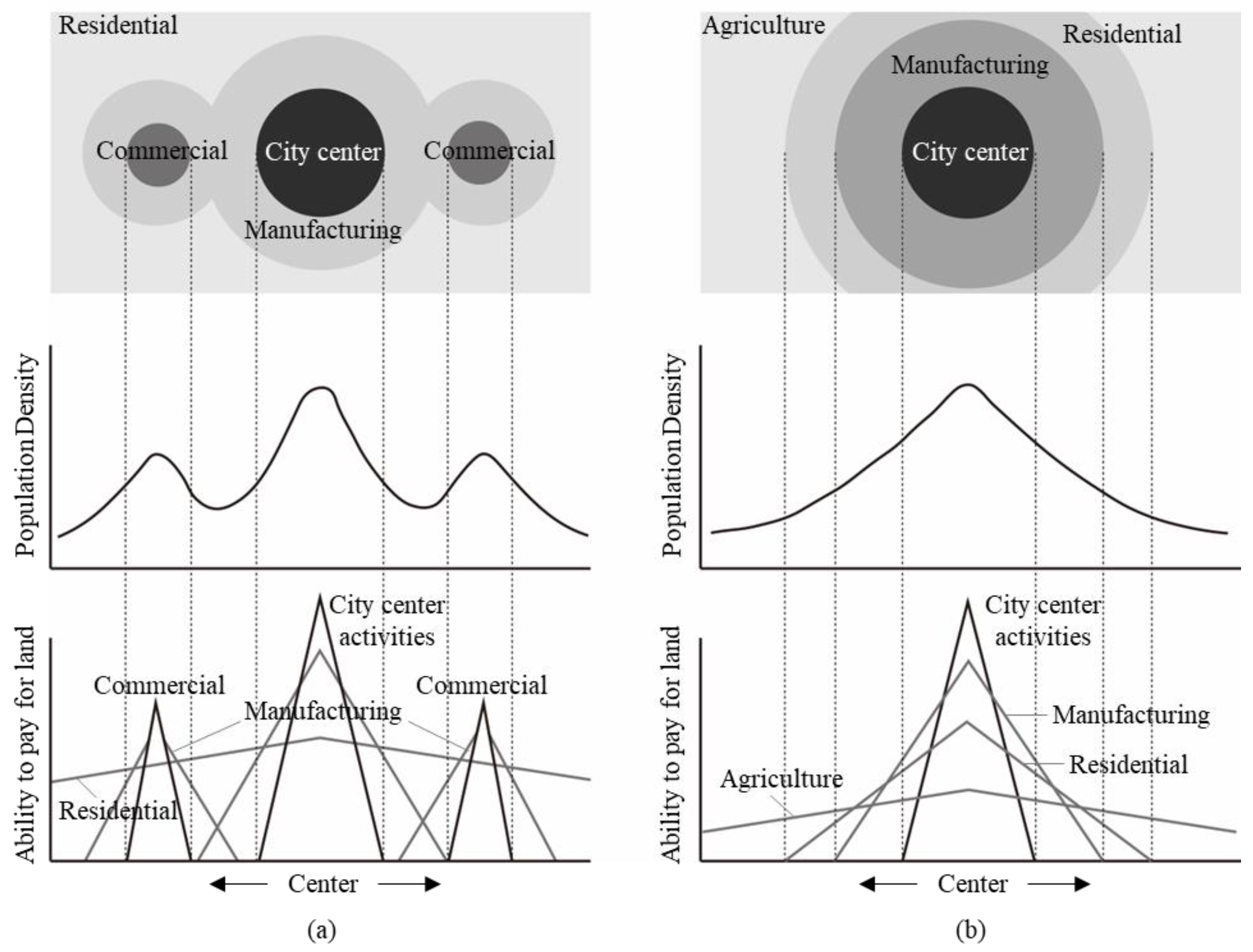
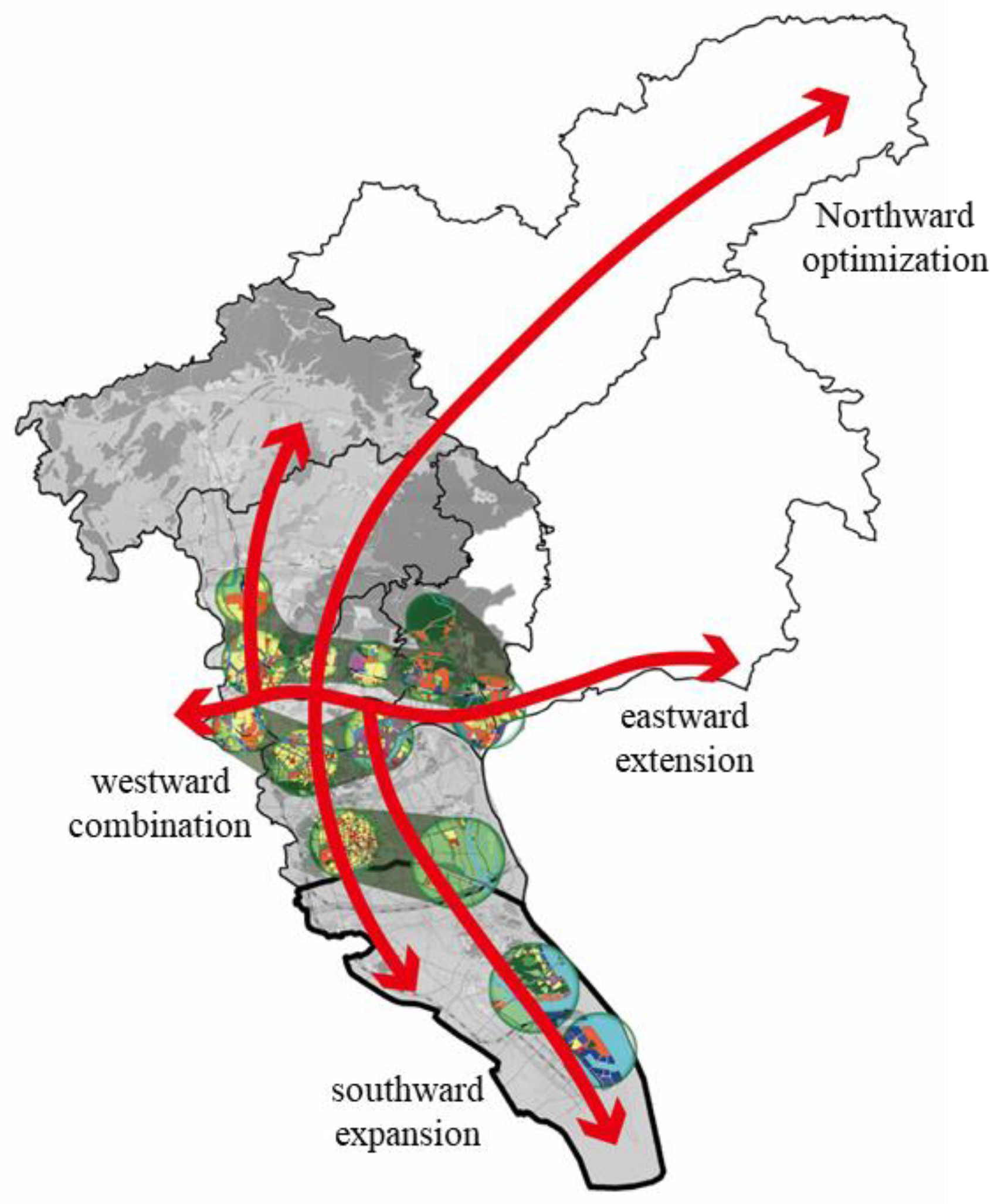

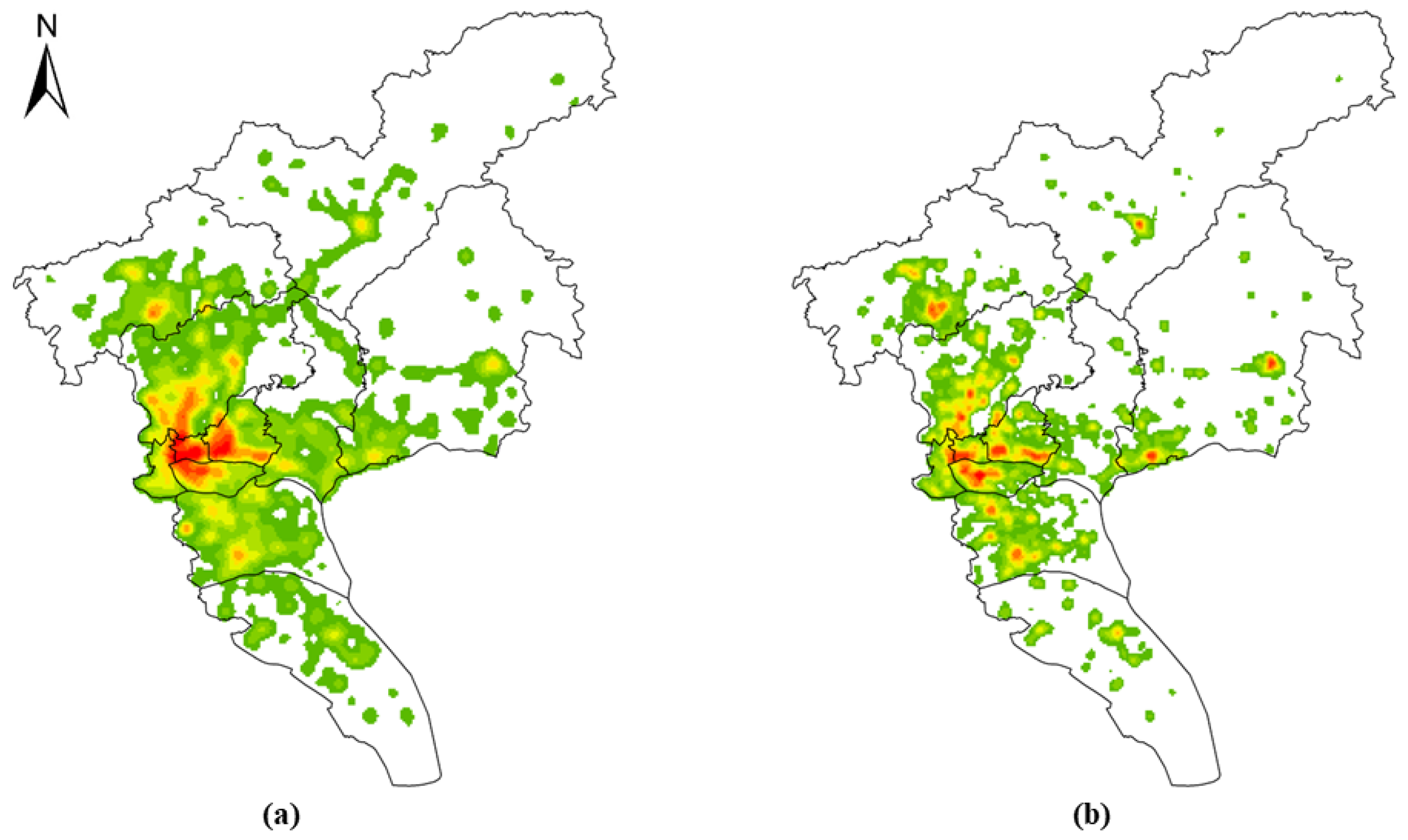
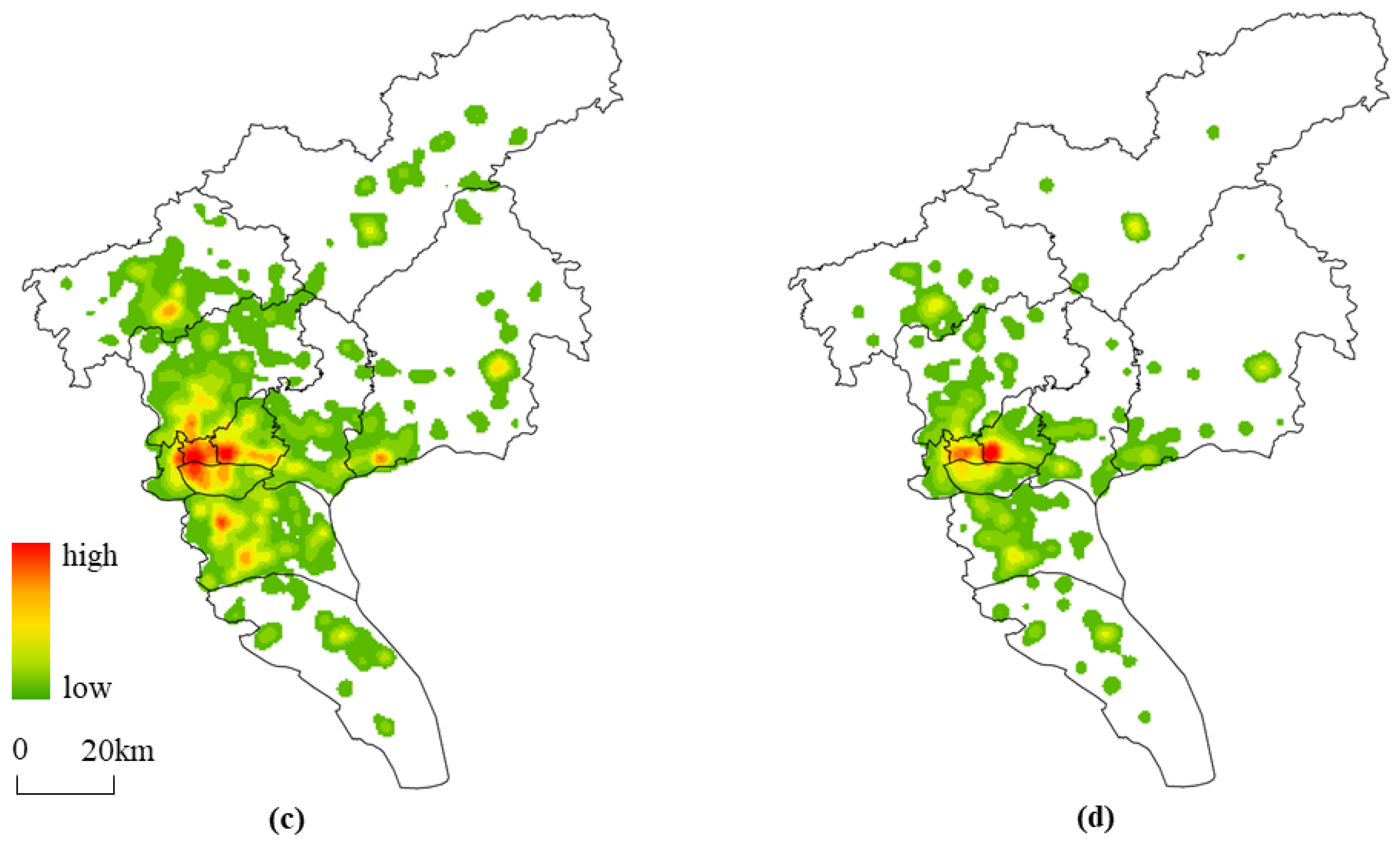
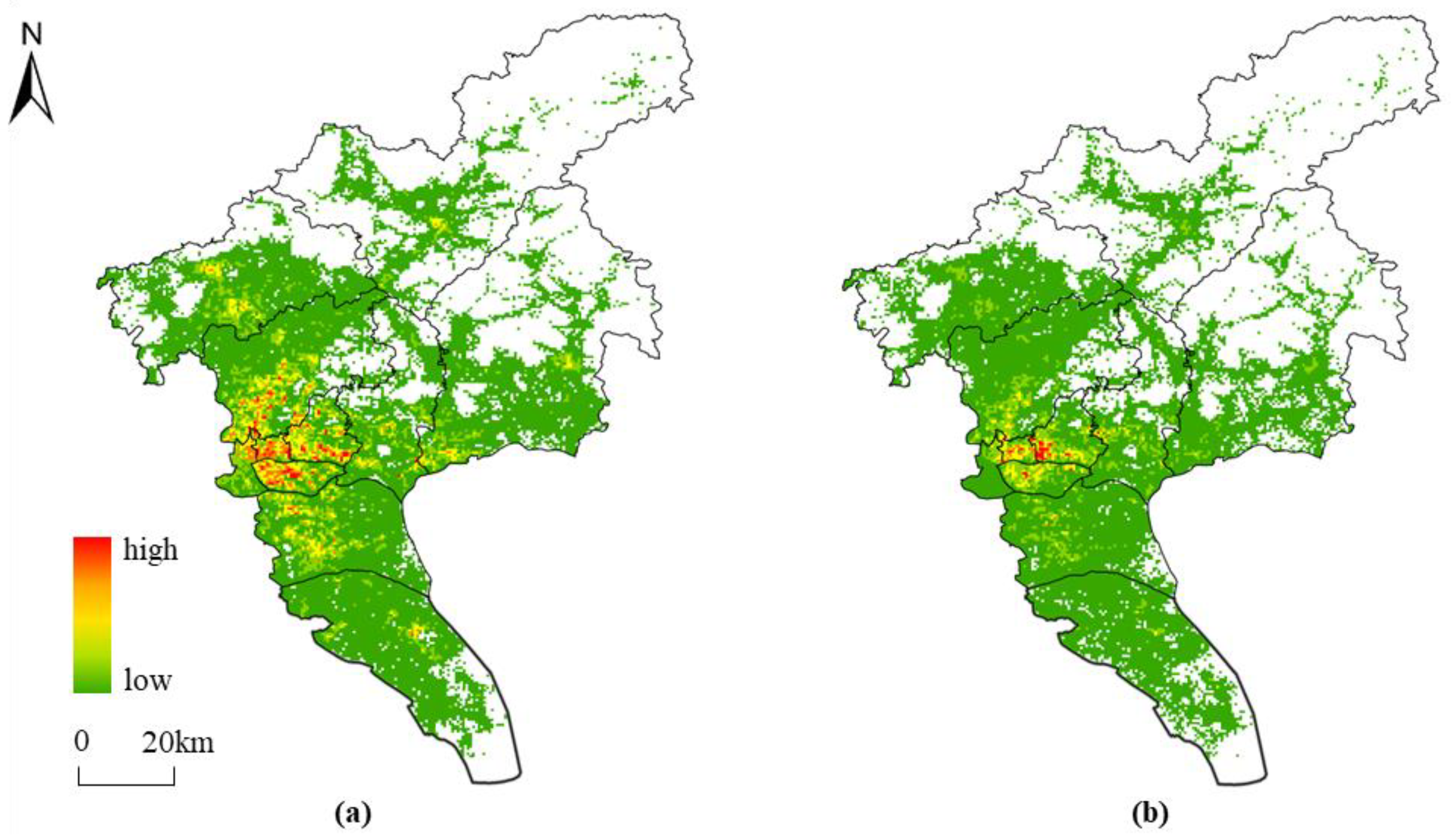
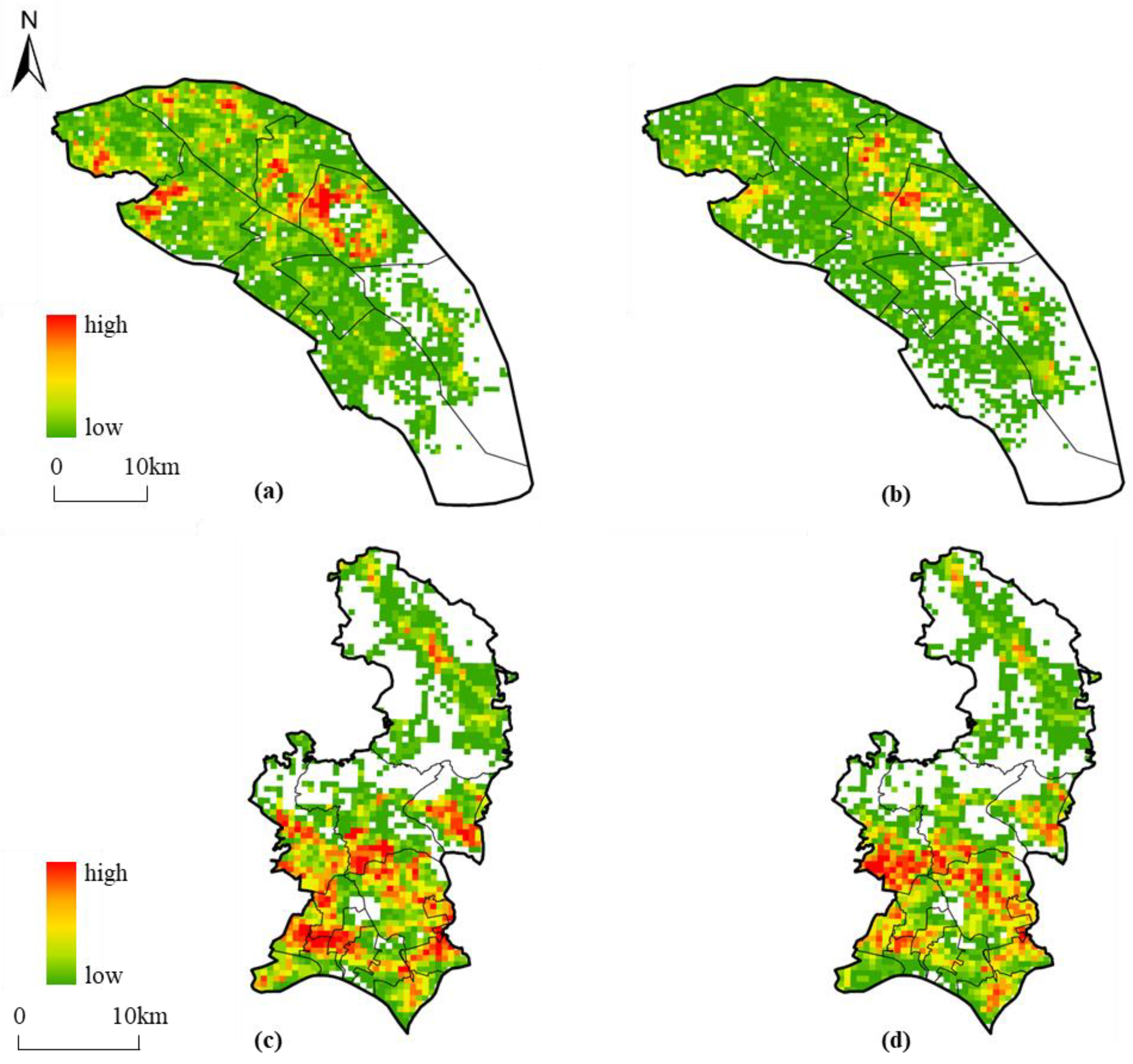

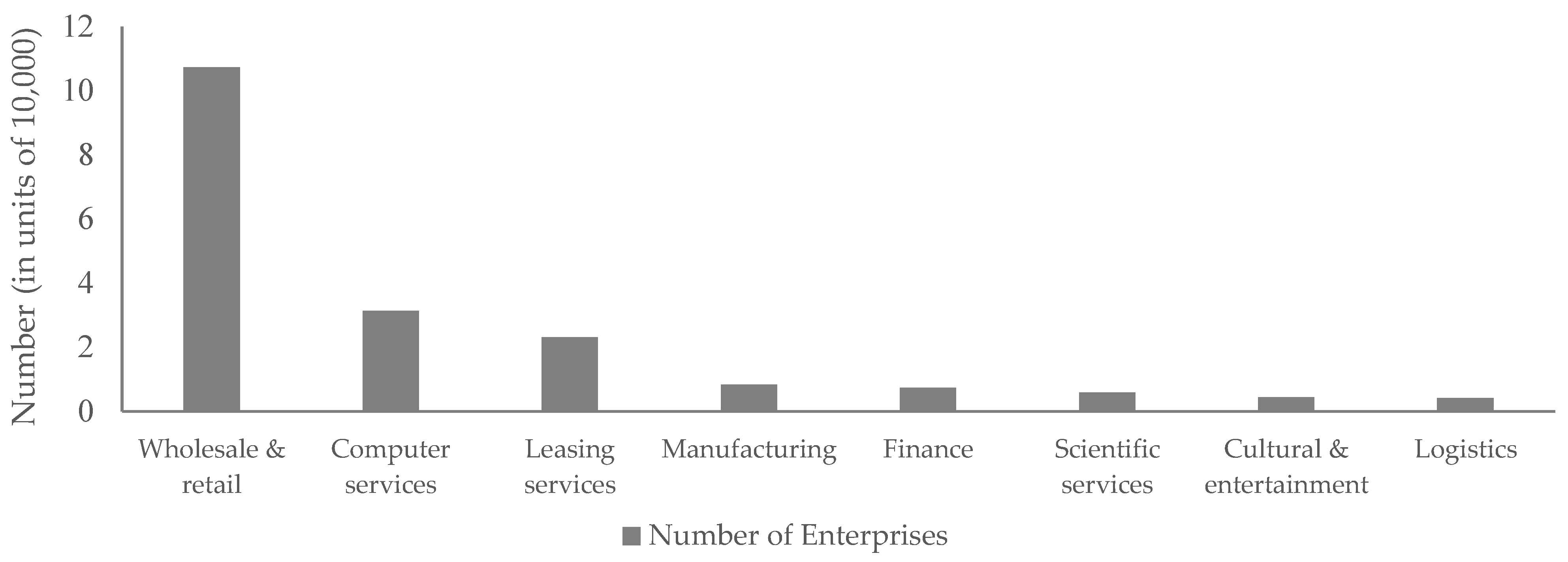
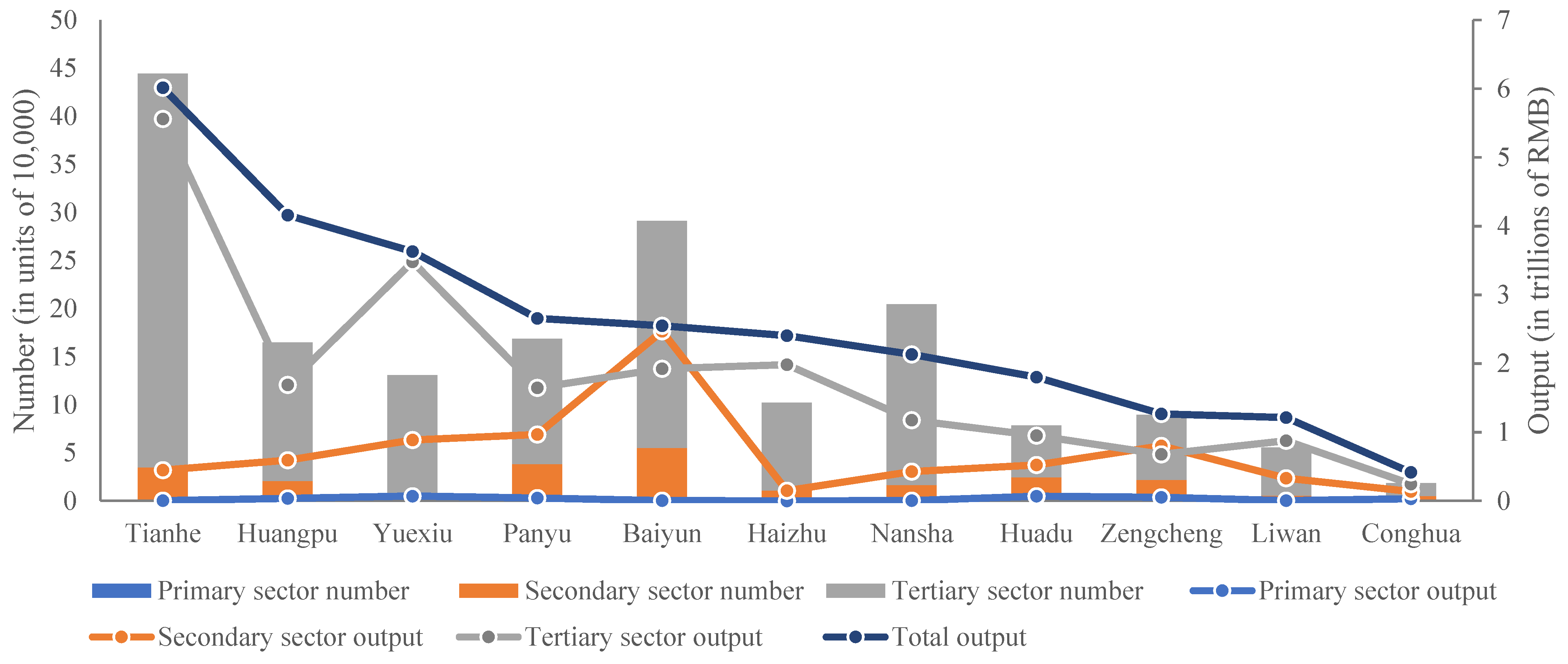
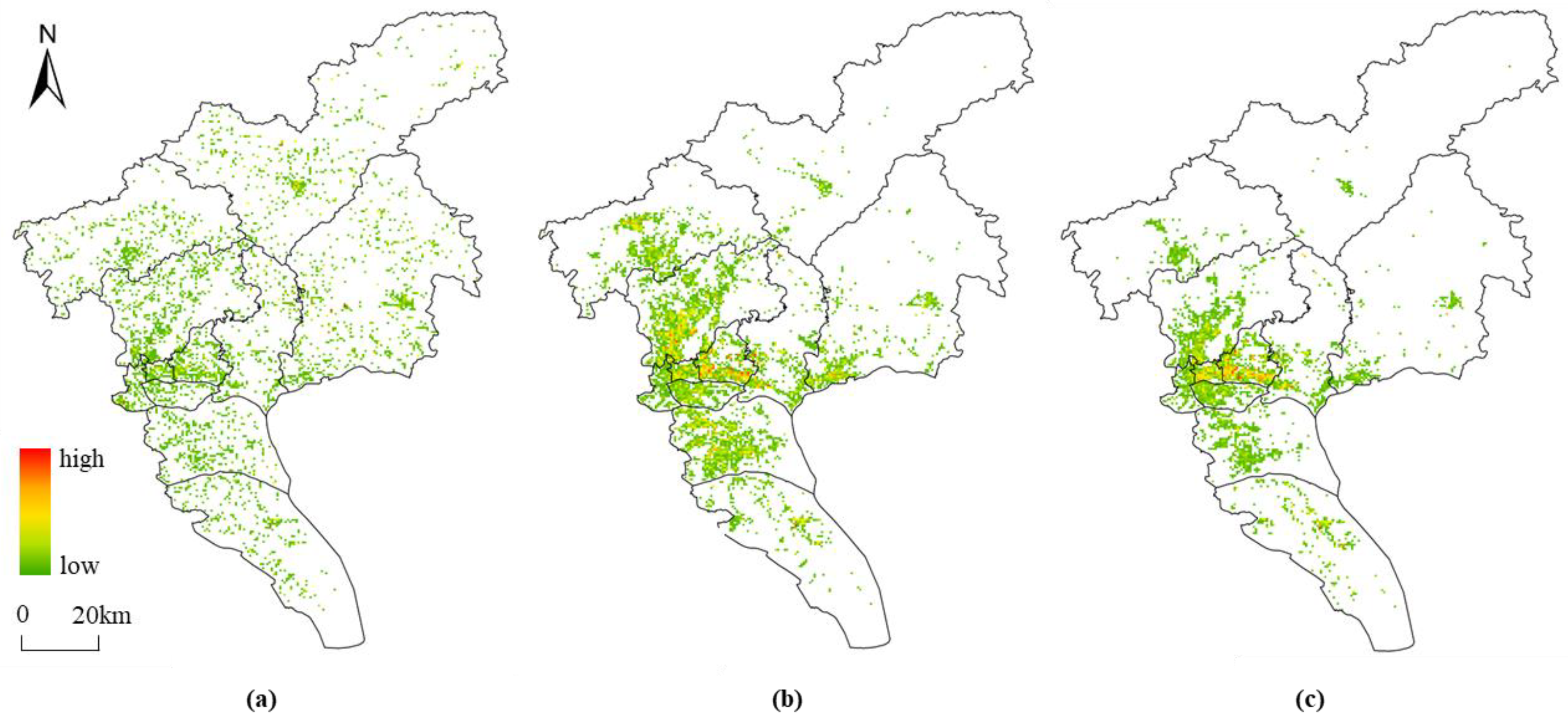
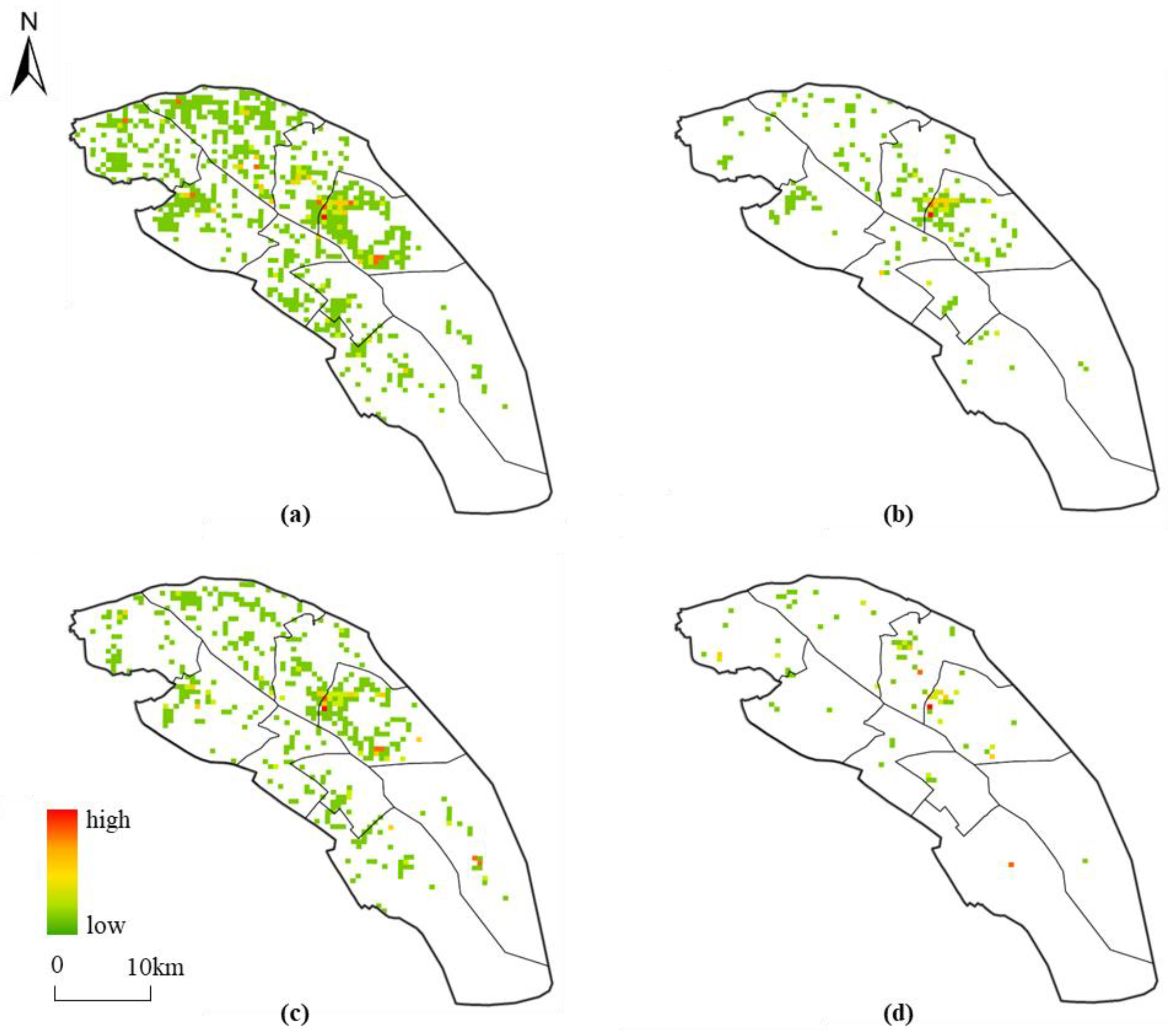
| Category | Sub-Categories | Quantity | Percentage (%) |
|---|---|---|---|
| Public services | Healthcare services, government agencies, transportation facilities, educational and cultural facilities | 46,835 | 12.48% |
| Catering/shopping services | Dining services, shopping services | 297,470 | 79.29% |
| Recreational services | Sports and entertainment venues, vacation resorts and health retreats, cinemas | 24,858 | 6.63% |
| Financial/insurance services | ATMs, insurance, investment and financial management, banks | 5960 | 1.59% |
| Planning Type | Issuing Authority | Documents |
|---|---|---|
| Regional Development Planning | Central Committee of the Communist Party of China, State Council of the People’s Republic of China, Guangdong Provincial Government | Outline Development Plan for the Guangdong-Hong Kong-Macao Greater Bay Area; Outline Plan for Reform and Development of the Pearl River Delta Region; Overall Plan for Deepening Comprehensive Cooperation with Hong Kong, Macao, and the Greater Bay Area in Nansha, Guangzhou |
| Urban Master Planning | Guangzhou Municipal People’s Government, State Council of the People’s Republic of China | Urban Master Plan of Guangzhou City, 1996–2010; Urban Master Plan of Guangzhou City, 2001–2010; Urban Master Plan of Guangzhou City, 2011–2020; Urban Master Plan of Guangzhou City, 2017–2035 |
| Strategic spatial planning | Guangzhou Municipal Planning and Natural Resources Bureau | Outline Plan for the Overall Strategic Concept of Urban Construction in Guangzhou; Guangzhou Urban Development Strategy Plan Towards 2049 |
| Nansha Regional Planning | Overall Plan for Nansha Development Zone; Development Plan for Nansha Area; Development Plan for Nansha New Area, Guangzhou, 2012–2025 |
| Year | Planning | Planning Focus |
|---|---|---|
| 2000 | Outline Plan for the Overall Strategic Concept of Urban Construction in Guangzhou | southward expansion, northward optimization, eastward extension, and westward combination; Achieving Urban Leapfrog Development |
| 2005 | Urban Master Plan of Guangzhou City, 2001–2010 | |
| 2016 | Urban Master Plan of Guangzhou City, 2011–2020 | Building a metropolitan area, two new city districts (Nansha and Huangpu), and three sub-centers (Huadu, Conghua, Zengcheng) |
| 2018 | Urban Master Plan of Guangzhou City, 2017–2035 | Setting Nansha as the sole sub-center of Guangzhou; Incorporating areas in Huangpu District (except for Jiulong Town) into the urban center |
| 2023 | Guangzhou Urban Development Strategy Plan Towards 2049 | Expanding to the south of the two seas (Nansha) and advancing to the east of the two rivers (Huangpu) |
| Year | Planning Documents | Industrial Positioning |
|---|---|---|
| 1988 | Conceptual Plan for Nansha | Logistics and freight transportation, tourism, science, commerce, and residential development |
| 1993 | Master Plan for Nansha Development Zone | Capital-intensive offshore processing |
| 2000 | Guangzhou Strategic Plan | Port + finance and high-tech industries + heavy industry |
| 2004 | Development Plan for Nansha (2005) | Ports and modern logistics + near-port industries, high-tech industries + steel, petrochemical, and automobile industries |
| 2012 | Development Plan for Nansha District (2012–2025) | Modern services, advanced manufacturing, high-tech industries |
| 2015 | Master Plan for Nansha (2015–2025) | Technology innovation industry, logistics, finance, international trade, high-end manufacturing |
| 2019 | Outline Development Plan for the Guangdong-Hong Kong-Macao Greater Bay Area | Technology innovation, financial services, international logistics |
| 2023 | Overall Plan for Deepening Guangdong-Hong Kong-Macao Greater Bay Area Cooperation in Nansha |
Disclaimer/Publisher’s Note: The statements, opinions and data contained in all publications are solely those of the individual author(s) and contributor(s) and not of MDPI and/or the editor(s). MDPI and/or the editor(s) disclaim responsibility for any injury to people or property resulting from any ideas, methods, instructions or products referred to in the content. |
© 2023 by the authors. Licensee MDPI, Basel, Switzerland. This article is an open access article distributed under the terms and conditions of the Creative Commons Attribution (CC BY) license (https://creativecommons.org/licenses/by/4.0/).
Share and Cite
Zhao, M.; Yao, Y.; Indraprahasta, G.S. Reflection on Guangzhou’s Strategic Spatial Planning: Current Status, Conflicts, and Dilemmas. Land 2023, 12, 1996. https://doi.org/10.3390/land12111996
Zhao M, Yao Y, Indraprahasta GS. Reflection on Guangzhou’s Strategic Spatial Planning: Current Status, Conflicts, and Dilemmas. Land. 2023; 12(11):1996. https://doi.org/10.3390/land12111996
Chicago/Turabian StyleZhao, Miaoxi, Yuexi Yao, and Galuh Syahbana Indraprahasta. 2023. "Reflection on Guangzhou’s Strategic Spatial Planning: Current Status, Conflicts, and Dilemmas" Land 12, no. 11: 1996. https://doi.org/10.3390/land12111996
APA StyleZhao, M., Yao, Y., & Indraprahasta, G. S. (2023). Reflection on Guangzhou’s Strategic Spatial Planning: Current Status, Conflicts, and Dilemmas. Land, 12(11), 1996. https://doi.org/10.3390/land12111996








